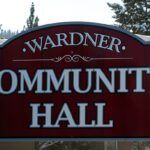Home »

Connecting people to connect wildlife
Kootenay Connect offers innovative approach to conservation efforts in region
By Nicole Trigg
Kootenay Conservation Program
With heat waves, wildfires, flooding and drought becoming the norm, Kootenay residents are waking up to the fact that the impacts of global warming are part of their everyday reality rather than in the distant future.
For our region’s fish and wildlife that are already coping with ongoing habitat loss due to human industrial use and development, climate change impacts are increasing their vulnerability. The Kootenay region is home to numerous endangered species that urgently require special conservation attention as they are forced to adapt to changing climate conditions.
It’s these dual crises – loss of biodiversity and accelerating climate change – that the Kootenay Connect project is trying to address at the local level.
An innovative, holistic approach to conservation, Kootenay Connect is a four-year project (2019-2023) administered by the Kootenay Conservation Program (KCP) and funded by Environment and Climate Change Canada (ECCC) through the Canada Nature Fund with equal matching funding from local partners.
Co-led by Marcy Mahr of KCP and independent biologist Dr. Michael Proctor of the Trans-Border Grizzly Bear Project, Kootenay Connect consists of a regional team of 26 organizations and specialists are working together with a collective goal to recover and sustain biodiversity across 10,000 km2 of Kootenay landscape by focusing on habitat connectivity and habitat restoration in four focus areas: the Bonanza Biodiversity Corridor (north of New Denver), Columbia Wetlands and Creston Valley (both of which are internationally-recognized wetlands), and Wycliffe Wildlife Corridor (near Cranbrook).
“Kootenay Connect is all about ecological connectivity,” said Mahr, Kootenay Connect Project Manager with KCP. “Although parks and protected areas have been essential for conservation, they are generally not large enough or sufficiently interconnected to sustain essential ecological processes and the diversity of habitats required by wide-ranging fish and wildlife that migrate and move in order to spawn, breed or overwinter. By focusing on the land and water surrounding and connecting existing protected areas, and by bringing together a team of biologists, land managers, land trusts, and stewardship organizations into the same tent to collectively problem-solve across areas of expertise and geographies, Kootenay Connect is ensuring that efforts to recover biodiversity and adapt to climate change are adding up to something greater.”
Over the past two years, Kootenay Connect’s work has focused on reducing threats and enhancing the sustainability of a spectrum of species including 31 federally-listed species at risk and 35 species of concern such as the Northern Leopard Frog, Western Painted Turtle, Western Toad, Lewis’s Woodpecker, Great Blue Heron, Northern Myotis (plus 12 other species of bats), American Badger, American Beaver, Mountain Goat, Grizzly Bear, and Wolverine.
The wide range of over 30 projects completed to date include: installing artificial tree bark to mimic old growth conditions for roosting bats to help keep these at-risk species on the landscape; adding more basking logs in important areas for endangered western painted turtles; removing vegetation and opening up and connecting wetland channels in the Creston Valley to improve water distribution for endangered Northern Leopard Frogs, work that has resulted in the highest egg reproduction in a decade for the only naturally breeding population left in B.C.; monitoring water levels of wetlands vulnerable to climate change in the Columbia Wetlands; and identifying important bird nesting areas and ungulate mineral licks to prepare applications for the Ministry of Forests, Lands, Natural Resource Operations and Rural Development requesting new designations of Wildlife Habitat Areas and Wildlife Habitat Features.
“It turns out that the region’s rich and abundant riparian-wetland complexes are the most important areas for connecting the valley bottoms and mountain ranges,” said Proctor, who has used these ecological corridors to identify biodiversity hotspots and conservation opportunities for at-risk and cultural important species across the Kootenay region. “The end goal is to have this information guide conservation efforts including land use designations by all levels of government and First Nations, land acquisitions by private land trusts, and environmental farm plans and incentives to provide ecosystem services on working farmlands.”
Canada has joined many other countries in supporting a global conservation target that calls for protecting at least 30% of the planet across terrestrial, freshwater and marine habitats by 2030 (known as “30X30”) in order to halt further degradation of ecosystems and loss of biodiversity, and to begin to reverse declining trends.
This international conservation inspiration has provided momentum for Kootenay Connect. According to Mahr, the Kootenay region is turning out to be just the right landscape size for combining local on-the-ground ecosystem restoration and other conservation measures and scaling them up into a regional approach that will help reverse species extinction and enhance ecological connectivity.
“Our ability to make a big conservation impact is possible because of the long-term relationships between people in our region, fostered by KCP, that is making sharing and collaboration easier than in other places. We’re connecting people to connect habitat for wildlife. Kootenay Connect is creating a culture of collaborative conservation with large landscape scale results that ultimately contribute globally,” added Mahr.
To learn more about this regional initiative, visit the Kootenay Connect webpage on the KCP website for project highlights including short informational videos, reports, and maps.
For more information, contact Kootenay Connect Program Manager Marcy Mahr at [email protected].
Lead image: Mountain goats visit a mineral link, which are important habitat features to protect in order to ensure healthy goats and other ungulates in the Kootenays. Photo credit: Janice Arndt.







